flat tire DODGE CALIBER 2010 1.G User Guide
[x] Cancel search | Manufacturer: DODGE, Model Year: 2010, Model line: CALIBER, Model: DODGE CALIBER 2010 1.GPages: 76, PDF Size: 12.18 MB
Page 43 of 76
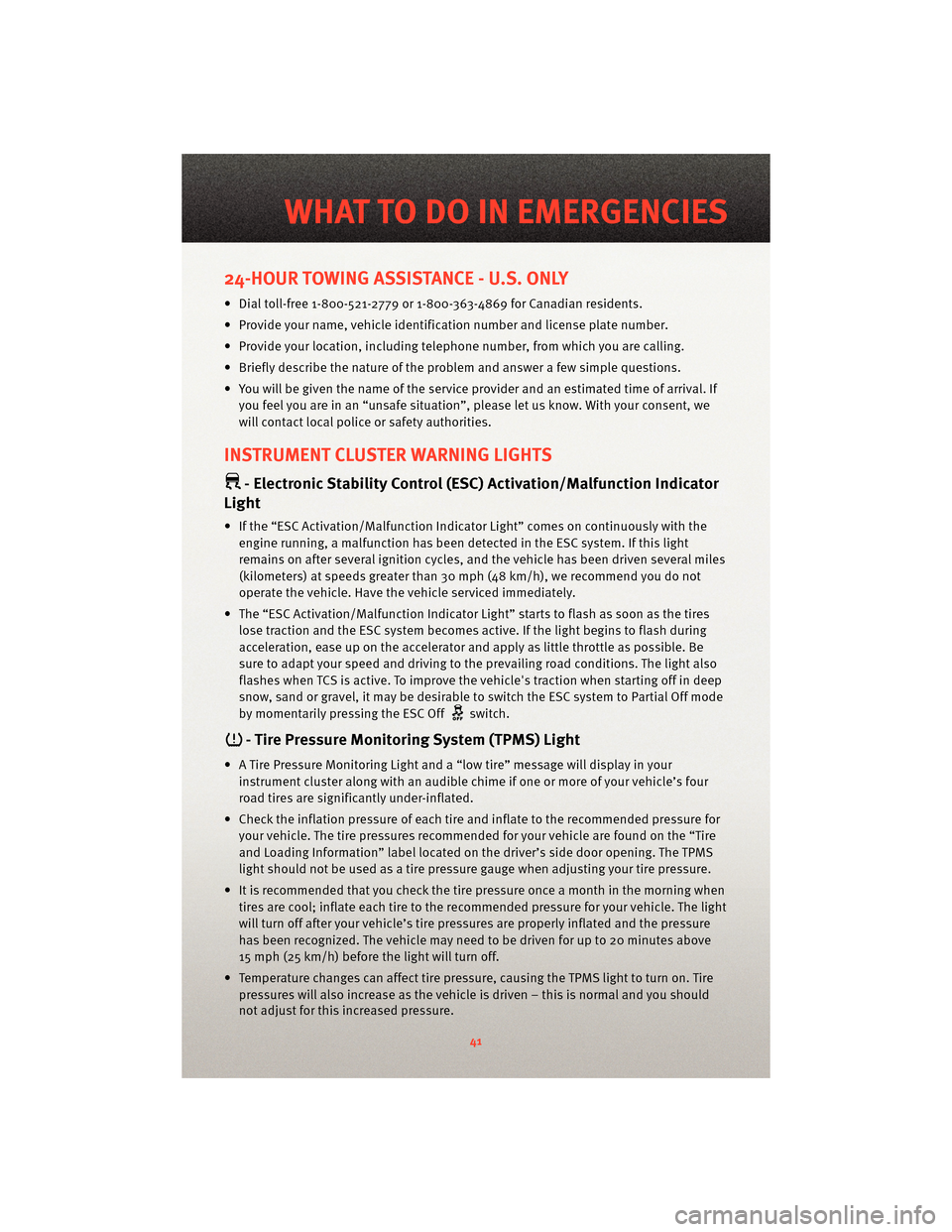
24-HOUR TOWING ASSISTANCE - U.S. ONLY
• Dial toll-free 1-800-521-2779 or 1-800-363-4869 for Canadian residents.
• Provide your name, vehicle identification number and license plate number.
• Provide your location, including telephone number, from which you are calling.
• Briefly describe the nature of the problem and answer a few simple questions.
• You will be given the name of the service provider and an estimated time of arrival. Ifyou feel you are in an “unsafe situation”, please let us know. With your consent, we
will contact local police or safety authorities.
INSTRUMENT CLUSTER WARNING LIGHTS
- Electronic Stability Control (ESC) Activation/Malfunction Indicator
Light
• If the “ESC Activation/Malfunction Indic ator Light” comes on continuously with the
engine running, a malfunction has been detect ed in the ESC system. If this light
remains on after several ignition cycles, and the vehicle has been driven several miles
(kilometers) at speeds greater th an 30 mph (48 km/h), we recommend you do not
operate the vehicle. Have the vehicle serviced immediately.
• The “ESC Activation/Malfunction Indicator Light” starts to flash as soon as the tires lose traction and the ESC system becomes active. If the light begins to flash during
acceleration, ease up on the accelerator and apply as little throttle as possible. Be
sure to adapt your speed and driving to the prevailing road conditions. The light also
flashes when TCS is active. To improve the vehicle's traction when starting off in deep
snow, sand or gravel, it may be desirable to switch the ESC system to Partial Off mode
by momentarily pressing the ESC Off
switch.
- Tire Pressure Monitoring System (TPMS) Light
• A Tire Pressure Monitoring Light and a “low tire” message will display in your instrument cluster along with an audible chime if one or more of your vehicle’s four
road tires are significantly under-inflated.
• Check the inflation pressure of each tire and inflate to the recommended pressure for your vehicle. The tire pressures recommended for your vehicle are found on the “Tire
and Loading Information” label located on the driver’s side door opening. The TPMS
light should not be used as a tire pressure gauge when adjusting your tire pressure.
• It is recommended that you check the tire pressure once a month in the morning when tires are cool; inflate each tire to the recommended pressure for your vehicle. The light
will turn off after your vehicle’s tire pressures are properly inflated and the pressure
has been recognized. The vehicle may need to be driven for up to 20 minutes above
15 mph (25 km/h) before the light will turn off.
• Temperature changes can affect tire pressure, causing the TPMS light to turn on. Tire pressures will also increase as the vehicle is driven – this is normal and you should
not adjust for this in creased pressure.
41
WHAT TO DO IN EMERGENCIES
Page 44 of 76
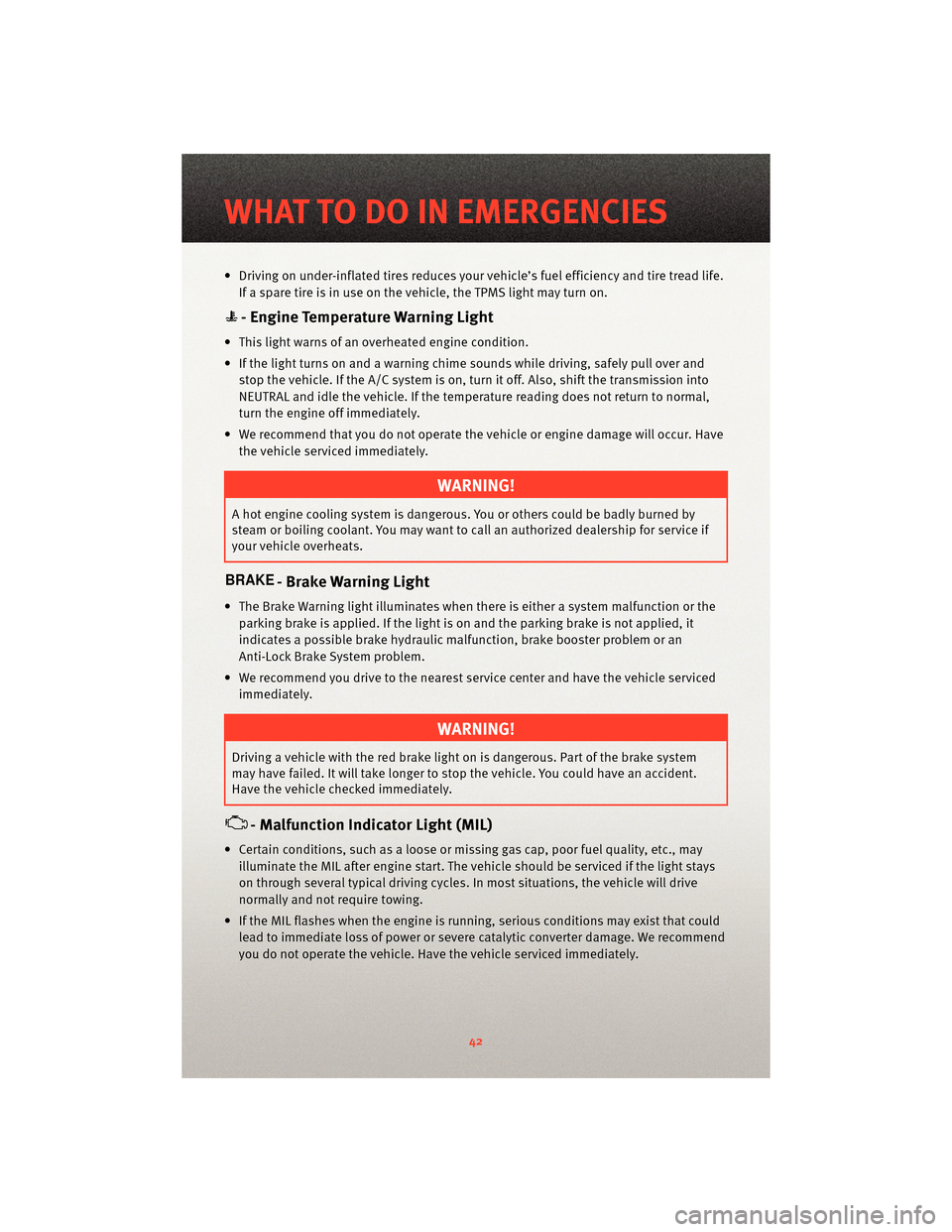
• Driving on under-inflated tires reduces yourvehicle’s fuel efficiency and tire tread life.
If a spare tire is in use on the vehicle, the TPMS light may turn on.
- Engine Temperature Warning Light
• This light warns of an overheated engine condition.
• If the light turns on and a warning chime sounds while driving, safely pull over and stop the vehicle. If the A/C system is on, t urn it off. Also, shiftthe transmission into
NEUTRAL and idle the vehicle. If the temperat ure reading does not return to normal,
turn the engine off immediately.
• We recommend that you do not operate the vehicle or engine damage will occur. Have the vehicle serviced immediately.
WARNING!
A hot engine cooling system is dangero us. You or others could be badly burned by
steam or boiling coolant. You may want to call an authorized dealership for service if
your vehicle overheats.
- Brake Warning Light
• The Brake Warning light illuminates when there is either a system malfunction or the
parking brake is applied. If the light is on and the parking brake is not applied, it
indicates a possible brake hydraulic malfunction, brake booster problem or an
Anti-Lock Brake System problem.
• We recommend you drive to the nearest service center and have the vehicle serviced immediately.
WARNING!
Driving a vehicle with the red brake light on is dangerous. Part of the brake system
may have failed. It will take longer to stop the vehicle. You could have an accident.
Have the vehicle checked immediately.
- Malfunction Indicator Light (MIL)
• Certain conditions, such as a loose or m issing gas cap,poor fuel quality, etc., may
illuminate the MIL after engine start. The vehicle should be serviced if the light stays
on through several typical driving cycles. In most situations, the vehicle will drive
normally and not require towing.
• If the MIL flashes when the engine is running, serious conditions may exist that could lead to immediate loss of power or severe catalytic converter damage. We recommend
you do not operate the vehicle. Hav e the vehicle serviced immediately.
WHAT TO DO IN EMERGENCIES
42
Page 48 of 76
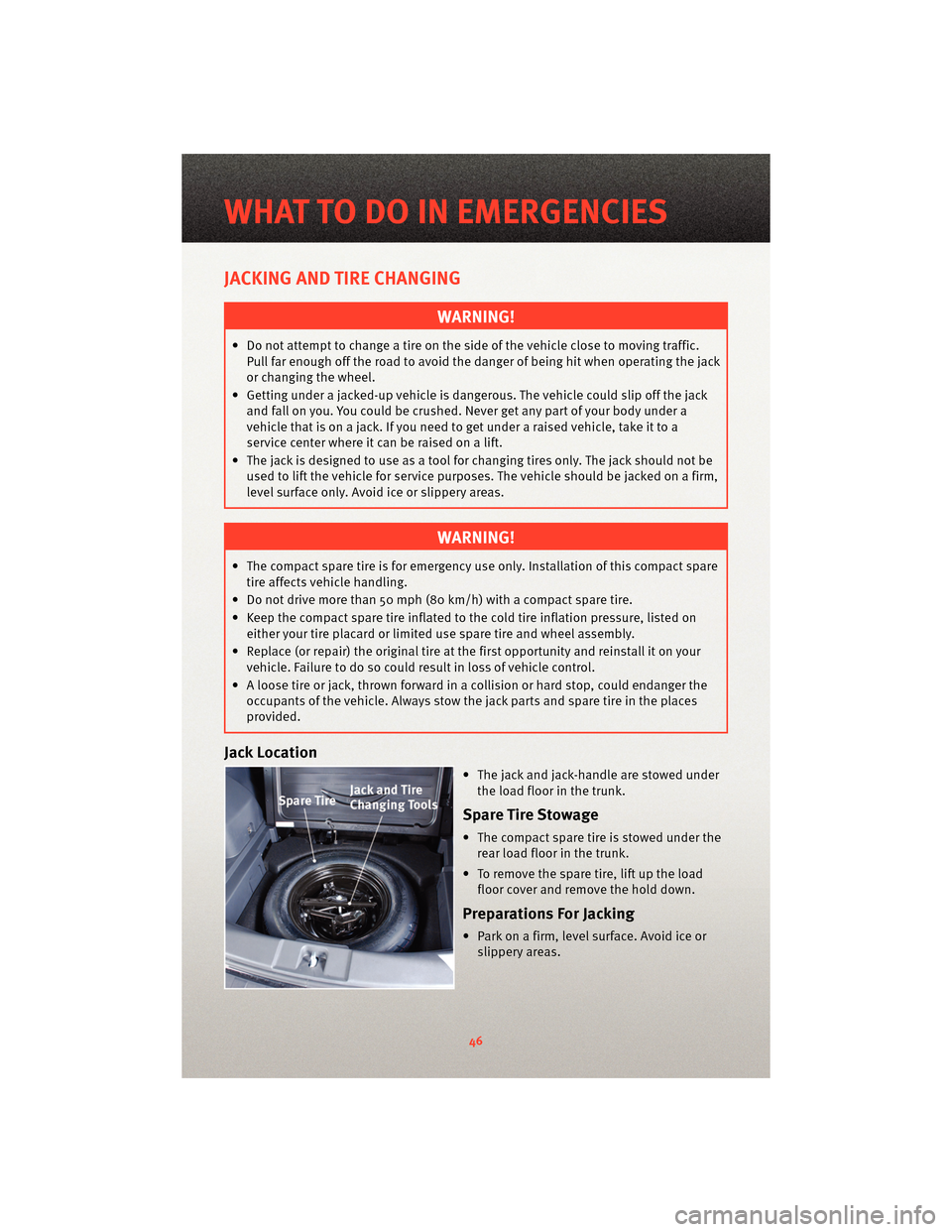
JACKING AND TIRE CHANGING
WARNING!
• Do not attempt to change a tire on the side of the vehicle close to moving traffic.Pull far enough off the road to avoid the danger of being hit when operating the jack
or changing the wheel.
• Getting under a jacked-up vehicle is dangerous. The vehicle could slip off the jack and fall on you. You could be crushed. Never get any part of your body under a
vehicle that is on a jack. If you need to get under a raised vehicle, take it to a
service center where it can be raised on a lift.
• The jack is designed to use as a tool for changing tires only. The jack should not be used to lift the vehicle for service purposes. The vehicle should be jacked on a firm,
level surface only. Avoid ice or slippery areas.
WARNING!
• The compact spare tire is for emergency use only. Installation of this compact sparetire affects vehicle handling.
• Do not drive more than 50 mph (80 km/h) with a compact spare tire.
• Keep the compact spare tire inflated to the cold tire inflation pressure, listed on either your tire placard or limited use spare tire and wheel assembly.
• Replace (or repair) the original tire at the first opportunity and reinstall it on your vehicle. Failure to do so could result in loss of vehicle control.
• A loose tire or jack, thrown forward in a collision or hard stop, could endanger the occupants of the vehicle. Always stow the jack parts and spare tire in the places
provided.
Jack Location
• The jack and jack-handle are stowed underthe load floor in the trunk.
Spare Tire Stowage
• The compact spare tire is stowed under therear load floor in the trunk.
• To remove the spare tire, lift up the load floor cover and remove the hold down.
Preparations For Jacking
• Park on a firm, level surface. Avoid ice orslippery areas.
WHAT TO DO IN EMERGENCIES
46
Page 50 of 76
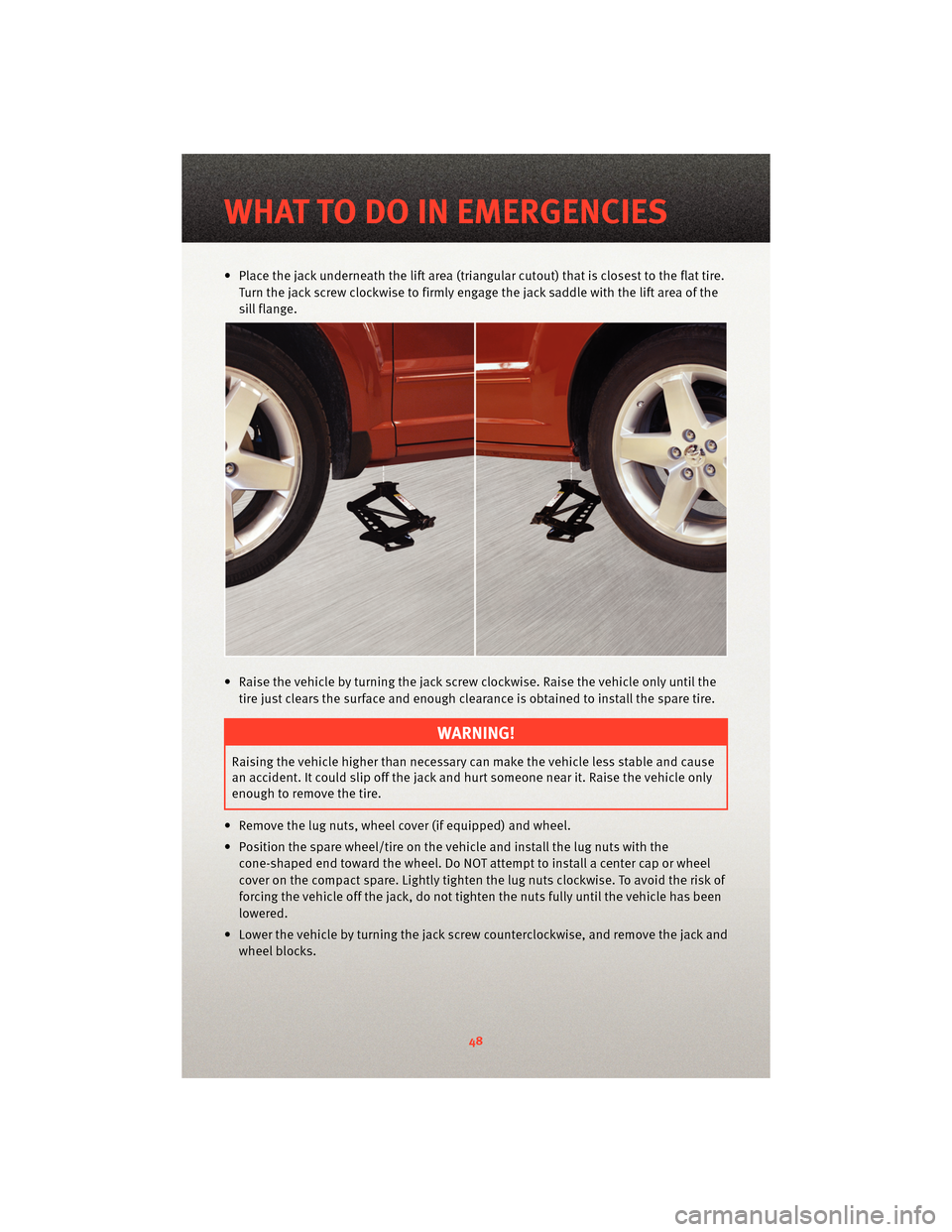
• Place the jack underneath the lift area (triangular cutout) that is closest to the flat tire.Turn the jack screw clockwise to firmly engage the jack saddle with the lift area of the
sill flange.
• Raise the vehicle by turning the jack screw clockwise. Raise the vehicle only until the tire just clears the surface and enough clearance is obtained to install the spare tire.
WARNING!
Raising the vehicle higher than necessary can make the vehicle less stable and cause
an accident. It could slip off the jack and hurt someone near it. Raise the vehicle only
enough to remove the tire.
• Remove the lug nuts, wheel cover (if equipped) and wheel.
• Position the spare wheel/tire on the vehicle and install the lug nuts with the cone-shaped end toward the wheel. Do NOT attempt to install a center cap or wheel
cover on the compact spare. Lightly tighten the lug nuts clockwise. To avoid the risk of
forcing the vehicle off the jack, do not tighten the nuts fully until the vehicle has been
lowered.
• Lower the vehicle by turning the jack screw counterclockwise, and remove the jack and wheel blocks.
WHAT TO DO IN EMERGENCIES
48
Page 65 of 76

Cavity Cartridge Fuse Mini-FuseDescription
22 10 Amp Red IGN RUN Heat/AC/Compass Sensor
23 15 Amp Lt Blue ENG ASD Relay Feed 3
24 15 Amp Lt Blue Power Sunroof Feed
25 10 Amp Red Heated Mirror (If Equipped)
26 15 Amp Lt Blue ENG ASD Relay Feed 2
27 10 Amp Red IGN RUN Only ORC Feed
28 10 Amp Red IGN RUN ORC/OCM Feed
29 Hot Car (No Fuse Required)
30 20 Amp Yellow Heated Seat (If Equipped)
31 10 Amp Red Headlamp Washer Relay Control (If
Equipped)
32 30 Amp Pink ENG ASD Control Feed 1
33 10 Amp Red ABS MOD/J1962 Conn/PCM
34 30 Amp Pink ABS Valve Feed
35 40 Amp Green ABS Pump Feed
36 30 Amp Pink Headlamp/Washer Control/Sm art Glass (If
Equipped)
37 25 Amp
NaturalDiesel Fuel Heater (If Equipped)
TIRE PRESSURES
• Check the inflation pressure of each tire, including the spare tire, at least monthly and
inflate to the recommended pressure for your vehicle.
• The tire pressures recommended for your vehicle are found on the “Tire and Loading Information” label located on the driver’s side door opening.
NOTE: Refer to the Owner's Manual on the DVD for more information on the life of tires.
WARNING!
Overloading of your tires is dangerous. Overloading can cause tire failure, affect
vehicle handling, and increase your stopping distance. Use tires of the recommended
load capacity for your vehicle. Never overload them.
WARNING!
Improperly inflated tires are dangerous and can cause accidents. Under-inflation is
the leading cause of tire failure and may result in severe cracking, component
separation, or “blow out”. Over-inflation r educes a tire’s ability to cushion shock.
Objects on the road and chuck holes can cause damage that results in tire failure.
Unequal tire pressures can cause steering problems. You could lose control of your
vehicle. Over-inflated or under-inflated ti res can affect vehicle handling and can fail
suddenly, resulting in loss of vehicle control.
63
MAINTAINING YOUR VEHICLE
Page 68 of 76
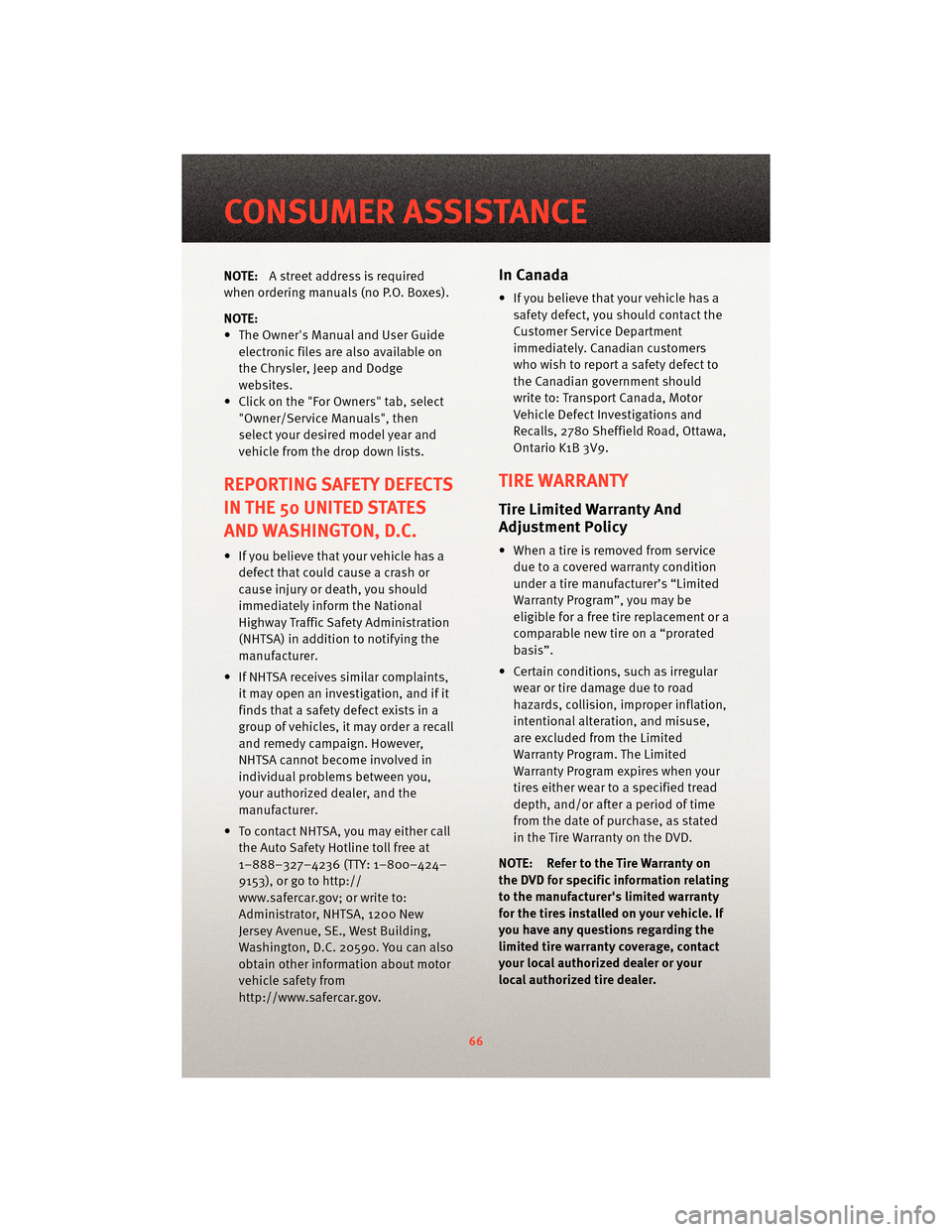
NOTE:A street address is required
when ordering manuals (no P.O. Boxes).
NOTE:
• The Owner's Manual and User Guide electronic files are also available on
the Chrysler, Jeep and Dodge
websites.
• Click on the "For Owners" tab, select "Owner/Service Manuals", then
select your desired model year and
vehicle from the drop down lists.
REPORTING SAFETY DEFECTS
IN THE 50 UNITED STATES
AND WASHINGTON, D.C.
• If you believe that your vehicle has adefect that could cause a crash or
cause injury or death, you should
immediately inform the National
Highway Traffic Safety Administration
(NHTSA) in addition to notifying the
manufacturer.
• If NHTSA receives similar complaints, it may open an investigation, and if it
finds that a safety defect exists in a
group of vehicles, it may order a recall
and remedy campaign. However,
NHTSA cannot become involved in
individual problems between you,
your authorized dealer, and the
manufacturer.
• To contact NHTSA, you may either call the Auto Safety Hotline toll free at
1–888–327–4236 (TTY: 1–800–424–
9153), or go to http://
www.safercar.gov; or write to:
Administrator, NHTSA, 1200 New
Jersey Avenue, SE., West Building,
Washington, D.C. 20590. You can also
obtain other information about motor
vehicle safety from
http://www.safercar.gov.
In Canada
• If you believe that your vehicle has asafety defect, you should contact the
Customer Service Department
immediately. Canadian customers
who wish to report a safety defect to
the Canadian government should
write to: Transport Canada, Motor
Vehicle Defect Investigations and
Recalls, 2780 Sheffield Road, Ottawa,
Ontario K1B 3V9.
TIRE WARRANTY
Tire Limited Warranty And
Adjustment Policy
• When a tire is removed from servicedue to a covered warranty condition
under a tire manufacturer’s “Limited
Warranty Program”, you may be
eligible for a free tire replacement or a
comparable new tire on a “prorated
basis”.
• Certain conditions, such as irregular wear or tire dam age due to road
hazards, collision, improper inflation,
intentional alteration, and misuse,
are excluded from the Limited
Warranty Program. The Limited
Warranty Program expires when your
tires either wear to a specified tread
depth, and/or after a period of time
from the date of purchase, as stated
in the Tire Warranty on the DVD.
NOTE: Refer to the Tire Warranty on
the DVD for specific information relating
to the manufacturer's limited warranty
for the tires in stalledon your vehicle. If
you have any questions regarding the
limited tire warranty coverage, contact
your local authorized dealer or your
local authorized tire dealer.
CONSUMER ASSISTANCE
66
Page 69 of 76
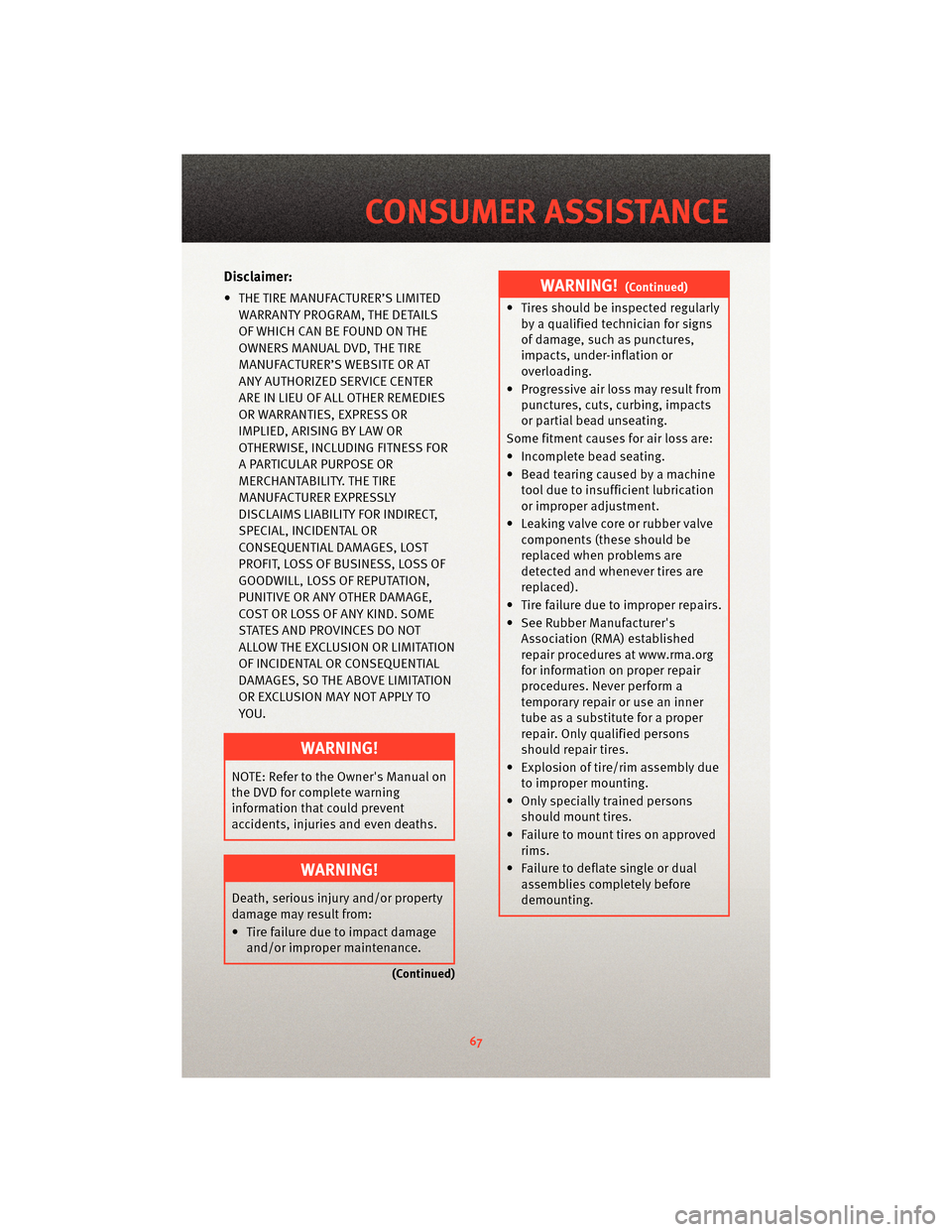
Disclaimer:
• THE TIRE MANUFACTURER’S LIMITEDWARRANTY PROGRAM, THE DETAILS
OF WHICH CAN BE FOUND ON THE
OWNERS MANUAL DVD, THE TIRE
MANUFACTURER’S WEBSITE OR AT
ANY AUTHORIZED SERVICE CENTER
ARE IN LIEU OF ALL OTHER REMEDIES
OR WARRANTIES, EXPRESS OR
IMPLIED, ARISING BY LAW OR
OTHERWISE, INCLUDING FITNESS FOR
A PARTICULAR PURPOSE OR
MERCHANTABILITY. THE TIRE
MANUFACTURER EXPRESSLY
DISCLAIMS LIABILITY FOR INDIRECT,
SPECIAL, INCIDENTAL OR
CONSEQUENTIAL DAMAGES, LOST
PROFIT, LOSS OF BUSINESS, LOSS OF
GOODWILL, LOSS OF REPUTATION,
PUNITIVE OR ANY OTHER DAMAGE,
COST OR LOSS OF ANY KIND. SOME
STATES AND PROVINCES DO NOT
ALLOW THE EXCLUSION OR LIMITATION
OF INCIDENTAL OR CONSEQUENTIAL
DAMAGES, SO THE ABOVE LIMITATION
OR EXCLUSION MAY NOT APPLY TO
YOU.
WARNING!
NOTE: Refer to the Owner's Manual on
the DVD for complete warning
information that could prevent
accidents, injuries and even deaths.
WARNING!
Death, serious injury and/or property
damage may result from:
• Tire failure due to impact damageand/or improper maintenance.
(Continued)
WARNING!(Continued)
• Tires should be inspected regularlyby a qualified technician for signs
of damage, such as punctures,
impacts, under-inflation or
overloading.
• Progressive air loss may result from punctures, cuts, curbing, impacts
or partial bead unseating.
Some fitment causes for air loss are:
• Incomplete bead seating.
• Bead tearing caused by a machine tool due to insufficient lubrication
or improper adjustment.
• Leaking valve core or rubber valve components (these should be
replaced when problems are
detected and whenever tires are
replaced).
• Tire failure due to improper repairs.
• See Rubber Manufacturer's Association (RMA) established
repair procedures at www.rma.org
for information on proper repair
procedures. Never perform a
temporary repair or use an inner
tube as a substitute for a proper
repair. Only qualified persons
should repair tires.
• Explosion of tire/rim assembly due to improper mounting.
• Only specially trained persons should mount tires.
• Failure to mount tires on approved rims.
• Failure to deflate single or dual assemblies completely before
demounting.
67
CONSUMER ASSISTANCE